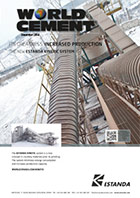Editorial comment
Back in the August 2014 issue, I discussed the launch of NASA’s Orbiting Carbon Observatory-2 (OCO-2), which has been designed to collect data on atmospheric carbon dioxide. Now, NASA has released ‘A Year in the Life of Earth’s CO2’, a video simulation that depicts the movement of carbon dioxide across the globe over the course of a year. The simulation, which can be found at www.worldcement.com, illustrates the differences in CO2 levels in the northern and southern hemispheres and the variations in CO2 concentrations throughout the seasons.
Register for free »
Get started now for absolutely FREE, no credit card required.
The simulation has been developed using the GEOS-5, an ultra-high resolution computer model created by NASA Goddard’s Global Modeling and Assimilation Office. It utilises real data on atmospheric conditions, GHG emissions, natural and man-made particulates from part of a simulation known as ‘Nature Run’, which covers May 2005 – June 2007. Computer modelling may be able to increase understanding of the pathways carbon dioxide takes from its source point to the atmosphere or carbon reservoirs (i.e. forests and oceans), complementing the data compiled by OCO-2. Indeed, upon watching the video, you will see the carbon dioxide ‘swirl and shift’ as it is dispersed away from its sources by the wind.
The simulation offers an entrancing and colourful snapshot of a topic that has become increasingly prominent at both a national and global level. One of the major talking points of President Obama’s meeting with China’s President Xi Jinping in November related to emission reduction targets. For the first time, China stated an approximation of when it expects its carbon emissions to peak – 2030. The country also intends to increase its utilisation of non-fossil fuels so that they comprise 20% of its primary energy mix by 2030. Meanwhile, after 2020, the US President has pledged to lower net GHG emissions to 26 – 28% below 2005 levels by 2025, doubling the country’s rate of carbon reduction from the pre-2020 period. As the world’s two largest economies, and its two biggest carbon emitters, the impact of such announcements from the US and China is likely to be far reaching. In the months and years ahead, we will see if and how such targets translate into legislation and the effect this will have upon cement and other industrial sectors.
In the meantime, World Cement would like to look to the more immediate future and wish you all a happy holiday season and a prosperous New Year. Thank you to all of our readers, authors and advertisers for your support throughout 2014. World Cement looks forward to continuing to serve as a platform for sharing best practice and innovation with the industry as we enter 2015. As always, you are invited to share your achievements and developments with us by sending them to editorial@worldcement.com.


